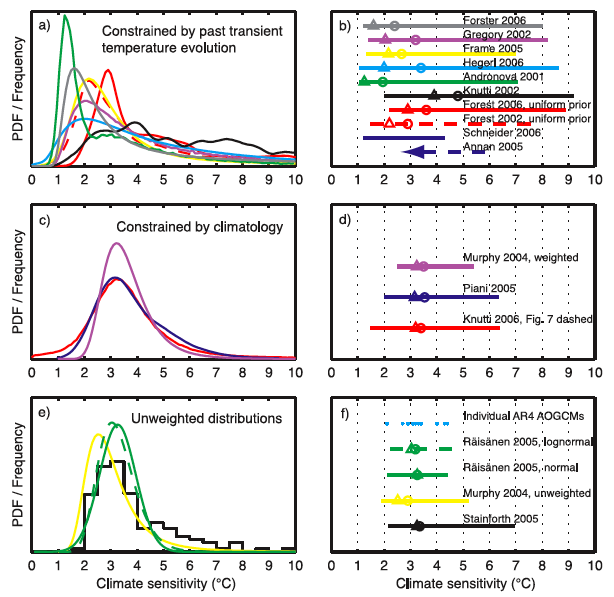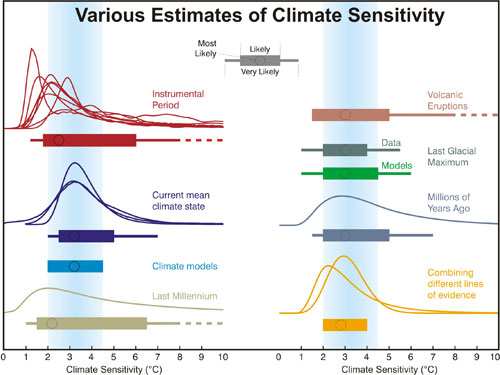Lindzen Illusion #4: Climate Sensitivity
 In his recent interview on an Australian radio talk show, Richard Lindzen discouraged the Australian public from implementing the country's proposed carbon tax. One of Lindzen's main points in justifying this position was his favorite argument, "climate sensitivity is low."
In his recent interview on an Australian radio talk show, Richard Lindzen discouraged the Australian public from implementing the country's proposed carbon tax. One of Lindzen's main points in justifying this position was his favorite argument, "climate sensitivity is low."
"The crucial thing is sensitivity: you know, what do you expect a doubling of CO2 to do? If it's only a degree, then you could go through at least two doublings and probably exhaust much of your fossil fuel before you would do anything that would bother anyone."
"If we doubled CO2, it's well accepted that you should get about 1 degree warming if nothing else happened. [...] But 1 degree is reckoned as not very significant. The question then is: is what we've seen so far suggesting that you have more than that, and the answer is no."
Really, Dr. Lindzen? "What we've seen so far" suggests that climate sensitivity is no higher than 1°C for a doubling of atmospheric CO2? Sorry, but that's a load of baloney.
Lindzen and Choi 2009
Perhaps by "we," Lindzen refers only to himself and Choi, who published a paper in 2009 which examined sea surface temperature in the tropics and satellite measurements of outgoing radiation over very short timeframes, concluding that climate sensitivity to doubled CO2 is just 0.5°C. However, the paper contained numerous fundamental flaws, and was soundly refuted by Trenberth et al. (2010), Lin et al. (2010), and Murphy (2010). Even fellow "skeptic" Roy Spencer expressed no confidence in Lindzen and Choi's results.
Lindzen has acknowledged that the paper contains errors and has claimed that addressing them will not significantly change its results, which still show climate sensitivity less than 1°C for doubled CO2. However, he submitted a revision over a year ago (February 2010), and it has still not been published, which suggests that the journal editors and reviewers were not satisfied with his efforts to respond to the criticisms.
Other Climate Sensitivity Estimates
Lindzen and Choi's paper is of course far from the only game in town in terms of estimating climate sensitivity. In fact there have been dozens of studies on the subject using a wide variety of methodologies, including both climate models and empirical observational data. Climate sensitivity has been estimated from paleoclimate data from millions of years ago, tens of thousands of years ago, the last few thousand years, the last few hundred years, from recent responses to large volcanic eruptions, to the solar cycle, and so on and so forth. These different methodologies have all been consistent with a sensitivity likely between 1.5 and 4.5°C, with a most likely value close to 3°C for doubled CO2 (Figures 1 and 2).

Figure 1: IPCC climate sensitivity estimates from observational evidence and climate models

And of course when we examined Lindzen's claim that "Earth hasn't warmed as much as expected" in Lindzen Illusion #1, and compared Lindzen and Hansen's temperature projections in Lindzen Illusion #2, in both cases we found that recent observational data is consistent with the IPCC's most likely climate sensitivity of 3°C, and inconsistent with Lindzen's purported sensitivity of below 1°C.
Water Vapor and Clouds
Lindzen has been arguing for low climate sensitivity for a long time. In an MIT tech talk Lindzen gave in 1989, he argued that two of the largest warming feedbacks, water vapor and clouds, are small or even negative.
"Water vapor is far and away the most important greenhouse gas, except for one form which isn't a greenhouse gas: clouds. Clouds themselves as liquid water are as important to the infrared budget as water vapor. "
"In the current models, for reasons that puzzle almost everyone, the cloud feedbacks are positive rather than negative."
"On the planet the most wonderful constituent is water with its remarkable thermodynamic properties. It's the obvious candidate for the thermostat of our system, and yet in most of these models, all water-related feedbacks are positive. I don't think we would have existed if that were true."
Up to the mid-1990s, Lindzen believed the water vapor feedback could be strongly negative due to a drying of the upper atmosphere (i.e. Lindzen 1991, Sun and Lindzen 1993, Lindzen 1996). However, in the late-1990s he began to change his stance on the water vapor feedback (i.e. Schneider et al. 1999). And indeed, numerous recent studies using empirical observational data have confirmed the positive water vapor feedback. For example, Dessler et al. (2008):
"Height-resolved measurements of specific humidity (q) and relative humidity (RH) are obtained from NASA's satellite-borne Atmospheric Infrared Sounder (AIRS)...The water-vapor feedback implied by these observations is strongly positive, with an average magnitude of λ q = 2.04 W/m2/K, similar to that simulated by climate models."
Thus Lindzen's over 20-year-long argument for low climate sensitivity really depends on the cloud feedback being strongly negative, more than offsetting the positive water vapor feedback (and other positive feedbacks like decreasing albedo from melting ice). So in 2001, Lindzen put forth his "adaptive infrared iris" hypothesis (Lindzen et al. 2001) in which he proposed that increased sea surface temperature in the tropics would result in reduced cirrus clouds and thus more infrared radiation leakage from Earth's atmosphere, creating a cooling effect.
However, the iris hypothesis has not withstood the test of time (i.e. Fu et al. 2001, Hartmann and Michelsen 2002, Lin et al. 2002). A number of recent studies have also been incompatible with a strongly negative cloud feedback (i.e. Chang and Coakley 2007, Eitzen et al. 2008, Clement et al. 2009, and Lauer et al. 2010). Perhaps the most convincing study thus far on the subject is Dessler (2010), which attempted to calculate the short-term cloud feedback using measurements by the Clouds and the Earth’s Radiant Energy System (CERES) instruments from March 2000 to February 2010.
Dessler concluded that the short term cloud feedback is 0.54 ± 0.74 (2σ) W m-2 K-1, i.e. far more likely to be positive than negative, although negative values can’t be ruled out based on this data. However, a small negative feedback is insufficient to support Lindzen's hypothesis that clouds will offset the other positive feedbacks and keep climate sensitivity below 1°C for doubled CO2.
Reality Check
Frankly, Lindzen's claim that "what we've seen so far" suggests sensitivity is no higher than 1°C for doubled CO2 could not be further from the truth. In reality, nothing credible we've seen so far suggests sensitivity is nearly as low as Lindzen claims. It's no wonder that Lindzen focuses so strongly on this argument, since climate sensitivity is the "skeptic" endgame, but as tends to be the case, the scientific evidence is not on Lindzen's side.
Once again, we find that Lindzen has been consistently wrong over the past two decades. It's unfortunate that as Australians are trying to determine whether and how to address the threats posed by global warming and climate change, Lindzen chose to misinform them with a number of factually incorrect statements.
Posted by dana1981 on Thursday, 5 May, 2011
 In his recent interview on an Australian radio talk show, Richard Lindzen discouraged the Australian public from implementing the country's proposed carbon tax. One of Lindzen's main points in justifying this position was his favorite argument, "climate sensitivity is low."
In his recent interview on an Australian radio talk show, Richard Lindzen discouraged the Australian public from implementing the country's proposed carbon tax. One of Lindzen's main points in justifying this position was his favorite argument, "climate sensitivity is low."


